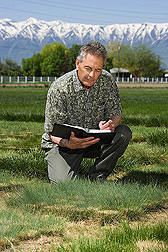This page has been archived and is being provided for reference purposes only. The page is no longer being updated, and therefore, links on the page may be invalid.
|
Read the magazine story to find out more. |
|
|
|
|
A Better Breed of Plants Help Revive Western Rangelands
By Ann PerryFebruary 12, 2010
For more than two decades, Agricultural Research Service (ARS) scientists have been developing new grasses and forages that can hold their own on the rugged rangelands of the western United States. As a result of that work, the scientists have released many improved plant varieties that help restore vegetation communities struggling for survival in the face of extreme weather conditions, wildfires, soil erosion, invasive plant species and other challenges.
Research leader Jack Staub and other scientists at the ARS Forage and Range Research Laboratory (FRRL) in Logan, Utah, use genetic material from both native and introduced plant sources in their breeding work. In some cases, they begin restoration efforts with introduced grasses and then follow up with the use of native plants as soil conditions improve.
In 1984, FRRL scientists partnered in the development of Hycrest crested wheatgrass, which became the leading crested wheatgrass grown on the western rangelands for approximately 10 years. It provides forage in the early spring and summer, stabilizes the soil, holds its own against aggressive invasive grasses and thrives in as little as 8 inches of annual precipitation.
Building on this success, FRRL scientists have now developed Hycrest II, which was bred for reseeding rangelands that have been overrun by annual weeds after wildfires, soil erosion and other disturbances. It offers improved establishment and exceeds Hycrest in seedlings established per acre.
Vavilov II, a Siberian wheatgrass cultivar that can help hold invasive cheatgrass at bay on especially dry and harsh sandy rangelands, was also created at the FRRL. And as competition for water supplies increases, FRRL scientists are developing pasture and turfgrasses better adapted to reduced irrigation. For instance, the meadow bromegrass cultivar Cache begins growth in the early spring and stays green and succulent longer than tall fescue and orchardgrass.
Results from this work have been published in the Journal of Plant Registrations, Native Plants Journal, Applied Turfgrass Science and elsewhere.
Read more about these studies and other plant varieties developed at the FRRL in the February 2010 issue of Agricultural Research magazine.
ARS is the principal intramural scientific research agency of the U.S. Department of Agriculture (USDA). This research supports the USDA priorities of promoting international food security and responding to climate change.

